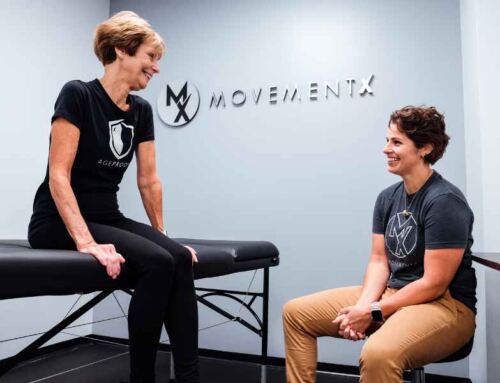Utilizing Physical Therapy to Manage Chronic Pain
In the United States, roughly 1 in 5 people, or 50 million total, are living with chronic or persistent pain (1).
Chronic pain can reduce quality of life, interfere with work and life activities, impact your ability to relax and focus, and carry a significant financial burden.
Professional physical therapy for chronic pain can help manage pain, restore mobility, and reduce the adverse outcomes that many individuals with chronic pain experience.
Learn more about chronic pain, how utilizing physical therapy can help manage chronic pain, and what to expect with your first PT appointment.
What Is Chronic Pain?
Put simply, chronic pain is pain that lasts for longer than 12 weeks.
But those that experience chronic pain understand that it is much more complex.
Acute pain typically results from an injury or irritation to a specific tissue or multiple tissues. For instance, if you drop something heavy on your foot, you will likely feel immediate pain, and the affected area will become red and swollen. Over the next few weeks as the tissues heal, the redness and swelling will go away, and the pain will gradually subside.
Pain essentially functions as an alarm system which alerts us to perceived threats in our environment. Painful stimuli trigger the alarm and may remain sensitive during the healing process, but over time returns to a normal baseline.
In individuals with chronic pain, pain persists beyond the time it takes for the tissues to heal. In these cases, the pain is not directly related to the injury or tissue damage, but rather to the brain and body’s alarm system perceiving threat in the environment.
In other words, the pain system remains in a state of “high alert”, even though the tissues themselves have healed.
To learn more about pain as an alarm system, check out this video: Pain Explained: How to Understand & Manage Pain – AgeProof Your Body
Types of PT Treatments for Chronic Pain
Fortunately, an abundance of research has pointed to several physical therapy treatment strategies that are effective in managing chronic pain by promoting function and by retraining how our pain systems respond to injury or perceived threat (2).
Types of PT treatments include:
- Education: PTs can provide you with trusted information about your individual condition and how lifestyle or environmental factors may play a role in your pain experience.
- Manual Therapy: To improve blood flow and relieve tightness, your physical therapist might employ manual therapy—trigger point release, myofascial release, cupping, and more—to help relax muscles and other soft tissues.
- Exercises: Helping to strengthen your body and improve mobility, different exercise types—strengthening, stretching, aerobics, and endurance—suggested by your physical therapist or trainer can help train your sensitive nervous system with safe movements and reduce pain.
- Other Modalities (heat, cold, TENS): Other modalities such as hot or cold packs or transcutaneous electrical nerve stimulation (TENS) may be useful in helping you manage your pain at home. Talk to your provider to determine what other options are best for you.
These are just a few of the most common types of treatments your physical therapist might utilize in treating your chronic pain. At MovementX, we place the highest priority on individualized, evidence-based care that is both effective and efficient. Your physical therapist should work with you one-on-one to develop a treatment plan targeting your specific needs and goals.
Benefits of PT for Managing Pain
Because chronic pain is often difficult to treat, many turn to physical therapy to not only help reduce pain but also to maximize function and quality of life. Physical therapists can help you regain ownership of your symptoms and your pain experience.
A few of the benefits of professional physical therapy include:
- Decrease pain and discomfort
- Improve balance and agility
- Strengthen muscles
- Improve flexibility or mobility
- Promote self-efficacy
- Prevent future injury
Additionally, your physical therapist will work with you to educate you on your individual experience of chronic pain and find the treatment solution that is right for you.
What To Expect With Your First Appointment
At your first appointment, your physical therapist will perform an extensive evaluation consisting of a complete medical history review, asking specific questions about your symptoms—how, when, and where the pain occurs—to get a better understanding of your pain experience.
They will also take strength and range of motion measurements and evaluate your postures and movement patterns. Based on these findings, your physical therapist will develop a personalized treatment plan to help you manage your chronic pain and achieve your goals.
At MovementX, our carefully crafted sessions are composed of manual therapy, movement analysis, and exercise programming tailored to your body’s needs.

1.) Manual Therapy
Manual therapy uses specific hands-on techniques to increase joint or soft tissue mobility, decrease pain, relax tight muscles, and engage the right muscles to move their best.

2.) Movement Analysis
We evaluate your mechanics to make sure every aspect of your movement system is working appropriately. Improving your posture and training your body to move more efficiently can help reduce your pain and improve your ability to perform everyday tasks.

3.) Exercise Programming
Based on your evaluation, your physical therapist will suggest corrective exercises that will help decrease pain, improve strength, and restore mobility. This can include strengthening exercises, low-impact aerobic exercises, and stretching practices—all modified to your unique abilities and movement capacity.
Conclusion
Living with and managing chronic pain can be challenging. MovementX physical therapists and personal trainers are here to support you. Every body deserves to move.
Connect with one of our specialists today.
References
- Yong, R. Jason; Mullins, Peter M.b; Bhattacharyya, Neilc. Prevalence of chronic pain among adults in the United States. PAIN: February 2022 – Volume 163 – Issue 2 – p e328-e332 doi: 10.1097/j.pain.0000000000002291
- Cosio D, Lin E. Role of Active Versus Passive Complementary and Integrative Health Approaches in Pain Management. Glob Adv Health Med. 2018 Apr 10;7:2164956118768492. doi: 10.1177/2164956118768492. PMID: 29662720; PMCID: PMC5896844.
About the Author
Dr. James McAfee is a physical therapist with MovementX in Seattle, WA. A graduate of both UCLA and USC, James McAfee believes that healthy movement across the lifespan relies on a healthy lifestyle. He helps clients reach their movement potential using an individualized approach around education, manual techniques, exercise, sleep, diet, and stress management.








